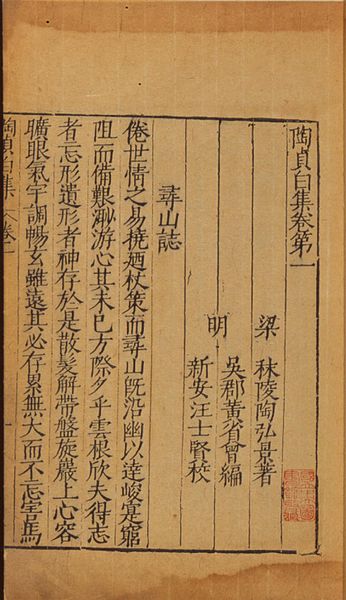Yang Xi, courtesy name Xihe, was an Eastern Jin dynasty scholar, calligrapher, and mystic, who is best known for the "Shangqing revelations" that were purportedly dictated to him by Taoist deities between 364 and 370. The Taoist polymath Tao Hongjing subsequently compiled and redacted Yang's revealed texts into the c. 499 Zhen'gao compendium, which formed the foundations of the Shangqing School of Taoism.
Stone rubbing of Dong Qichang's 1603 Huangting jing (黃庭經, Yellow Court Scripture), attributed to Wang Xizhi, but which Dong said was modeled on the calligraphy of Yang Xi.
Statues of the Three Lords Mao (Mao Ying 茅盈, Mao Gu 茅固, and Mao Zhong 茅衷), Tongxuan Taoist Temple, Hangzhou
Tao Hongjing (456–536), courtesy name Tongming, was a Chinese alchemist, astronomer, calligrapher, military general, musician, physician, and pharmacologist during the Northern and Southern dynasties (420–589). A polymathic individual of many talents, he was best known as a founder of the Shangqing "Highest Clarity" School of Taoism and the compiler-editor of the basic Shangqing scriptures.
Tao Hongjing Listening to the Pines, 1442 (Muromachi Period), Yamanashi Prefectural Museum
Xunshan zhi (尋山志, "Rhapsody on Exploring the Mountains") that Tao Hongming wrote at the age of fifteen, Ming dynasty (1573–1620) edition
Dunhuang manuscript of preface to Tao Hongjing's Bencao jizhu (本草集注, Collected Commentaries to the Shennong Ben Cao Jing), dated 718





